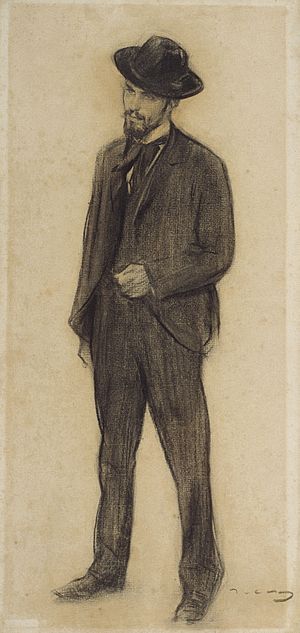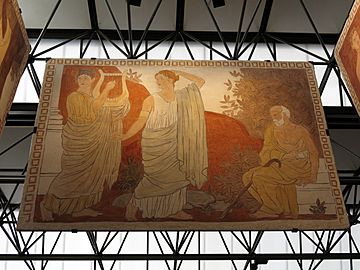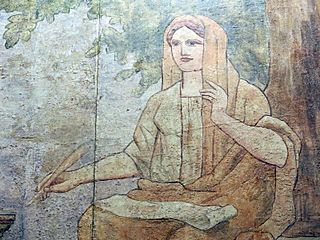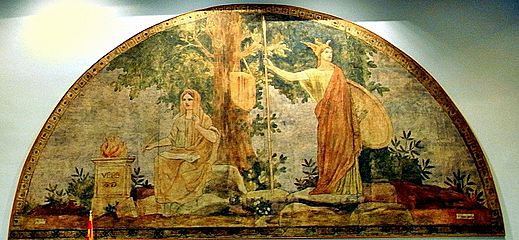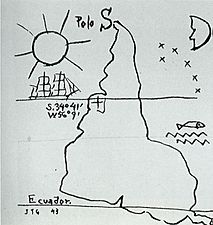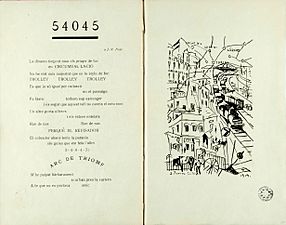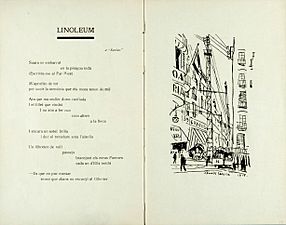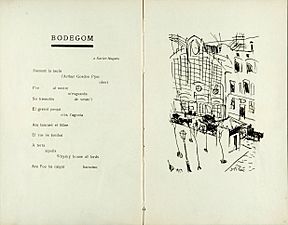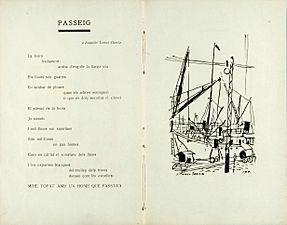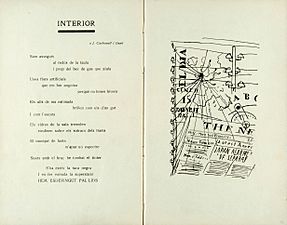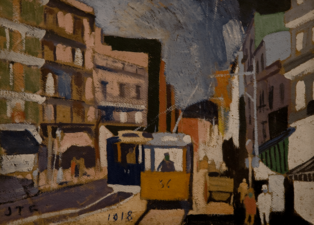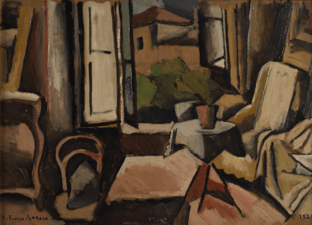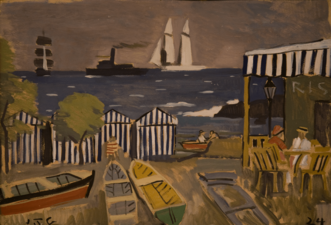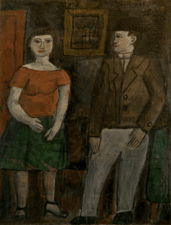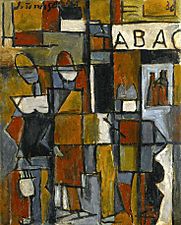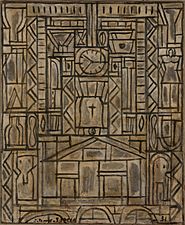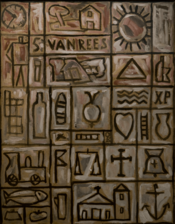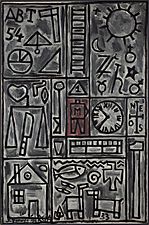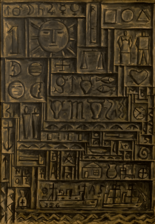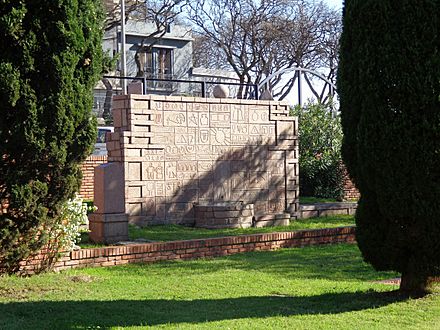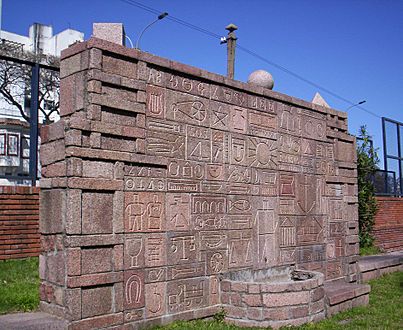Joaquín Torres-García facts for kids
Quick facts for kids
Joaquín Torres García
|
|
|---|---|
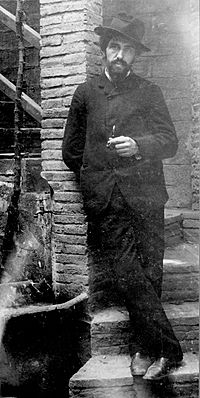
Torres-García at the Sagrada Família in Barcelona in 1903
|
|
| Born |
Joaquín Torres Garcia
28 July 1874 Montevideo, Uruguay
|
| Died | 8 August 1949 (aged 75) Montevideo, Uruguay
|
| Nationality | Uruguayan, Spanish |
| Education | Escuela Oficial de Bellas Artes Barcelona |
| Known for | Painting, sculpture, writing, teaching, illustration |
| Movement | Modern art, noucentisme, constructivism |
Joaquín Torres García (born July 28, 1874 – died August 8, 1949) was a famous artist from Uruguay and Spain. He was a painter, sculptor, writer, and teacher. Torres García was born in Montevideo, Uruguay. When he was a teenager, his family moved to Catalunya, Spain. This is where he started his amazing art journey.
He lived and worked mostly in Spain. But he also spent time creating art in the United States, Italy, France, and Uruguay. Torres García is well-known for starting two important art styles: Modern Classicism and Universal Constructivism.
When he was young, Torres García worked with the famous architect Antoni Gaudí. They created beautiful stained-glass windows for the Palma Cathedral and the Sagrada Família. He also decorated the old Palau de la Generalitat de Catalunya with large paintings in the Modern Classic style. Later, in the 1930s in Paris, Torres García developed his own special art style called Universal Constructive Art.
Torres García wrote over 150 books, essays, and articles. He also gave more than 500 lectures about art. He started art schools in Spain and Montevideo. He also created several art groups, including the first abstract art group in Europe, called Cercle et Carré (Circle and Square), in Paris in 1929.
After he passed away, his art was shown in big exhibitions in Paris (1955) and Amsterdam (1961). These shows helped people understand how important Torres García was in the world of abstract art. The Museum of Modern Art in New York bought one of his paintings to start its Latin American art collection. The Solomon R. Guggenheim Museum also had a big exhibition of his work in 1971. More recently, his art was shown in New York in 2015 and 2018.
Early Life and Art Journey
Growing Up (1874–1900)
Joaquín Torres García was born on July 28, 1874, in Montevideo, Uruguay. This city was a busy port surrounded by the South American Pampas grasslands. He was the first child of Joaquim Torras Fradera, who was from Spain, and María García Pérez. Joaquín grew up helping in his father's general store.
He learned a lot by watching the world around him. He saw the wagons bringing goods to the store and the many gauchos (South American cowboys). His first formal art lessons happened when his family moved back to Spain.
In 1891, his father decided to return to Spain with the family. They became Spanish citizens. Joaquín quickly showed a talent for art. He studied with a local painter. When the family moved to Barcelona, he joined several art schools. These included the School of Fine Arts in Barcelona and the Saint Lluc Artists Circle.
Torres García and Pablo Picasso were both young artists in Barcelona at the same time. They often met at a famous cafe called Els Quatre Gats. Other friends and classmates included Ricard Canals and Isidre Nonell. Torres García's drawings were published in popular newspapers and magazines like La Vanguardia. In 1900, his father passed away.
New Beginnings (1901–1909)
In 1903, the famous architect Antoni Gaudí asked Torres García to create stained-glass windows for the Palma Cathedral. This was a very important project for him. He made beautiful windows that showed symbols from old stories. These symbols, like the sun, moon, and stars, appeared in his art throughout his life. He also painted murals for other churches and houses.
Torres García started teaching art in 1907. He worked at an experimental school called Colegio Mont d'Or. Here, students learned to draw real objects instead of just copying pictures. This way of teaching helped him develop his unique style, which he later called Universal Constructivism. In 1909, Torres García married Manuela Piña i Rubíes. They had four children together.
Travels and New Ideas (1910–1919)
In 1910, Torres García traveled to Brussels to paint for a big World Fair. He also spent time in Paris, visiting museums and galleries. His art started to show influences from cubism, an art style that uses geometric shapes. He also saw futurism during a trip to Italy and Switzerland.
In 1912, he had two art shows at the Galeries Dalmau in Barcelona. One was his own show, and the other was with Pablo Picasso. Torres García published his first book about art, Notes on Art, in 1913. He then started his own art school, the School of Decoration.
He was asked to paint large frescoes (wall paintings) for the Municipal Palace of Barcelona. These paintings became a new symbol for the art movement of that time. Torres García painted four large frescoes over five years. One of them showed a giant god with a quote that meant "What is temporary is only a symbol." This idea was very important to Torres García. He believed that art could show eternal truths through everyday things.
In 1918, Torres García began exploring grid patterns in his art. He saw these grids in modern cities and used them to arrange symbols and everyday objects. He also created "Artistic Toys" for children. These toys were designed to teach kids about colors and shapes in a fun way.
In 1919, Torres García visited the United States. He wanted to experience the energy of New York City. He felt that the busy city and its skyscrapers connected with his ideas about modern art.
Paris and Constructivism (1920–1929)
Torres García visited Paris again in 1920. His friend Picasso advised him to stay there. Torres García's art changed from classic styles to Cubism. He then went to New York, planning to stay for two years. He lived in Manhattan and drew many sketches of the city's movement and atmosphere. He also painted portraits and scenes of Broadway. He showed his work in New York galleries in 1922.
Later that year, Torres García returned to Italy. He continued to develop his art. In 1926, he had another solo exhibition in Barcelona.
In 1926, Torres García moved back to Paris for six years. He became a key figure in the abstract art movement there. He showed his frescoes, murals, and city landscapes. He was part of group shows and had solo exhibitions. He also wrote articles for a Catalan magazine, interviewing other painters like Georges Braque. He believed that art could explore modernity using both reason and intuition.
Universal Constructivism (1930–1939)
For Torres García, Constructivism was about creating a new art language. He wanted to balance real-life images with abstract signs, while still keeping a traditional structure. He had two solo exhibitions in Paris in 1931. He also participated in a group show with famous artists like Alberto Giacometti, Joan Miró, and Salvador Dalí.
He founded the magazine Cercle et Carre with Theo van Doesburg. They brought together 80 artists to promote abstract art. Torres García then moved to Madrid and finished his book Arte Constructivo, which was published in 1935.
In April 1934, he returned to Montevideo, Uruguay, for the first time since he was a child. He exhibited his paintings and sculptures there. He also republished his magazine as Circulo y Cuadrado. In 1937, he published his autobiography, Story of My Life. Two years later, he started working on a large pink-granite sculpture called Monumento Cosmico. This was a very important work from this period.
Later Years and Legacy (1940–1949)
In 1940, Torres García closed his art school, the Association of Constructive Art. He had given over 500 lectures during his time there. In 1941, he published a book called A City With No Name. He also had a solo exhibition in Uruguay.
In 1944, Torres García founded the Taller Torres Garcia (Torres Garcia Workshop). This school was similar to the famous European Bauhaus school. Many future artists studied there, including Gonzalo Fonseca and José Gurvich, as well as his sons, Horacio and Augusto. That same year, he painted a mural for the Sindicato Médico del Uruguay. He also created seven large murals for a tuberculosis hospital.
Joaquín Torres García passed away on August 8, 1949, from a heart attack. He was preparing for two new exhibitions at the time.
Influences and Legacy
Torres García's art was shaped by modern art from Europe, North America, and South America. His style became more abstract over time. Even Pablo Picasso, who was seven years younger, was influenced by him. Joan Miró was one of Torres García's students in Barcelona and said his teacher had a big impact on his work. Torres García's constructive paintings also influenced the development of geometric abstract art in Latin America.
Works
Mon Repos frescoes (1914)
Palau de la Generalitat (1913-1917)
The Joaquín Torres-García Hall in the Palace of the Generalitat of Catalonia displays the frescoes he painted. He worked on these wall paintings from 1912 to 1916. The four finished frescoes are called La Catalunya Eterna (Catalunya Eternal), L'Etat d'Or (The Golden Age), Les Muses (The Muses), and Lo temporal no es mes que simbol (The Temporal is Nothing But a Symbol). These murals were hidden for many years, from 1926 to 1966.
Paintings (1918-1943)
Monumento Cosmico (1938)
Selected Writings
- Notes on Art, Barcelona, 1913
- Discovery of Oneself, 1914
- Advice to Artists, Barcelona, 1917
- Art-Evolution, Barcelona, 1917
- Art in Relation to the Eternal Man and the Passing Man, Sitges, 1919
- Poems on Hertzian Waves, 1919 (illustrator)
- What I Know, and What I Do by Myself, Losones, Switzerland, 1930
- Reason and Nature, Paris, 1932
- Structure, Montevideo, 1935
- From the Andean Tradition: Pre-Columbian Art, Montevideo, 1936
- Manifesto 2: Constructive 100 %, Montevideo, 1938
- The Tradition of the Abstract Man (Constructivist Doctrine). Montevideo, 1938
- Story of My Life. Montevideo, 1939
- Metaphysics of Indo-American Prehistory, Montevideo, 1939
- Manifesto 3, Montevideo, 1940
- A City With No Name. Montevideo, Uruguay, 1942
- Constructive Universalism, Montevideo, 1944
- The Mural Decoration of the Martirené Pavilion of the Saint Bois Colony. Montevideo, 1944
- In Defense of Modern Art Expressions, Montevideo, 1944
- New Art School of Uruguay. Montevideo, 1946
- The Abstract Rule. Montevideo, 1946
- Mysticism of Painting, Montevideo, 1947
- The Apparent and the Concrete in Art, Montevideo, 1948
- The Recovery of the Object, Montevideo, 1948
Selected Paintings
- The Laundry, oil on canvas, 1903
- The Laundry House, oil on canvas on wood, 1903
- The Painter with His Family 1917
- Construction in White and Black at the Museum of Modern Art (1938)
- Constructive City with Universal Man
- Composition
Major Exhibitions
- April 12 - June 29, 2018, The Worlds of Joaquín Torres-Garcia, Acquavella Galleries, New York.
- October 25, 2015 – February 15, 2016, Joaquín Torres-García: the Arcadian Modern, Museum of Modern Art, New York
- December 29, 2013 – March 2, 2014, Art & Textiles: fabric as material and concept in modern art from Klimt to the present, Kunstmuseum Wolfsburg, Germany
- April 22, 2013 – June 30, 2013, From Picasso to Barceló: Spanish Sculpture of the 20th Century, National Art Museum of China
- May 16 – September 11, 2011, Torres-García at his Crossroads, Museu Nacional d'Art de Catalunya (MNAC), Barcelona
- March 27, 2009, Traces of New York, Torres-Garcia Museum, Montevideo
- December 2008 - April 2009, Torres García to Vieira da Silva, 1929–1949, IVAM, Valencia, Berardo Collection Museum, Portugal
- October 8, 2005 – February 15, 2006, The Fire Under the Ashes: from Picasso to Basquiat, Fondation Dina Vierny-Musée Maillol, Paris
- October 7, 2005 – February 19, 2006, Masterpieces of the 20th Century in the collections of the IVAM, Valencia
- November 25, 2003 – April 11, 2004, Torres-Garcia, Museu Picasso, Barcelona
- 2003, Jean-Michel Basquiat-Gaston Chaissac-Jean Dubuffet-Joaquin Torres-Garcia, Jan Krugier Gallery, New York
- September 2002, From Puvis De Chavannes to Matisse and Picasso: Toward Modern Art, Palazzo Grassi, Venice
- May 24 – September 8, 2002, Joaquin Torres-Garcia: a Constructed World: Museum of Modern and Contemporary Art, Strasbourg
- May 31 – August 23, 1992 Joaquin Torres-Garcia and Theo van Doesburg, The Stedelijk Museum, Amsterdam
See also
 In Spanish: Joaquín Torres García para niños
In Spanish: Joaquín Torres García para niños


